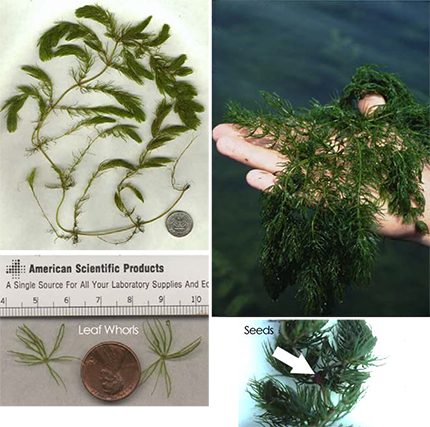Submerged Aquatic Vegetation (SAV) Identification Key
Main_Content
The bay grass key was designed to allow you to identify most species of bay grasses found in Maryland. Although bay grasses are notoriously difficult to identify using standard taxonomic keys, the flexible format of the Internet allows us to combine detailed pictures, simple line drawings and text messages in a stepwise sequence that makes identifying bay grasses simple. You may find it useful to have a clear metric ruler with millimeters marked, a magnifying glass, and a Ziploc plastic bag to help you in the process of identifying your plant.

|
If you already know the identity of a particular bay grass use the drop down boxes below. |
|---|
Common Name:
or
Scientific Name:
| | Common Name: | Coontail, Hornwort |
| | Scientific Name: | Ceratophyllym demersum |
| | Native or Non-native: | Native
|
| | Illustration: | 
|
| | Link to larger illustration: | |
| | Printable Version: | |
| | Family: | Ceratophyllaceae |
| | Distribution: | Coontail (also commonly known as Hornwort) is cosmopolitan in the Mid-Atlantic, usually grows in freshwater reaches of tributaries, lakes or ponds with moderate to high nutrient concentrations. The stiff, brushy growth of coontail is fragile and as such it is limited to slow moving water. It can also be found in the interior of large beds composed of other bay grass species. Unlike other SAV, coontail has no true roots and it can grow free-floating. Because of it's ability to absorb enough nutrients from the water column, coontail can grow in any substrate. |
| | Recognition: |
Coontail, because it has no true roots, may float in dense mats beneath the water surface and is only occasionally attached to the sediment by its basal ends. Coontail has slender, densely branched stems of up to 2.5 m (9 ft) in length. The compound leaves of coontail are divided or forked into linear and flattened segments 1 cm to 3.5 cm (2/5 in to 1 3/5 in) long with fine teeth on one side of the leaf margin. Leaves have a stiff and brittle texture and grow in whorls of 9 to 10 at each stem node with whorls becoming more crowded towards the stem tips. |
| | Ecological Significance: | Coontail is found in all 50 states and Puerto Rico. Unlike the other bay grasses found in the Chesapeake Bay, coontail has no true roots and obtains all its nutrients directly from the water column. It is very shade tolerant and can form large, dense mats in tidal freshwater tributaries of the bay and in slow-moving streams and ponds. These dense mats can provide habitat for small fish, aquatic animals, and aquatic insects. Coontail can also be eaten by some waterfowl, but it is not an important food source like other species of SAV. Also, since Coontail is so good at absorbing nutrients from the water, it can provide water quality benefits in areas with unconsolidated sediments where no other SAV can grow. |
| | Similar Species: | Eurasian watermilfoil ( Myriophyllum spicatum) has roots and pinnate leaves and is very different in form from coontail, appearing more feathery and limp when held out of the water. |
| | Reproduction: |
Coontail reproduces asexually (vegetatively) and sexually (by seed). Stem fragments with lateral buds develop into new plants throughout the season. In autumn stem tips break off and over-winter on the bottom before sprouting in spring. Occasional sexual reproduction produces small purple flower clusters between July and September, followed by a single nut-like seed. Shade-tolerance and its floating habit make turbidity less of a limiting factor for coontail than for other bay grasses. |
|
|
Center_Content
For permission to reproduce individual photos, please contact Mike Naylor
The text and photos used in this key were produced through a collaborative effort among the following partners.

